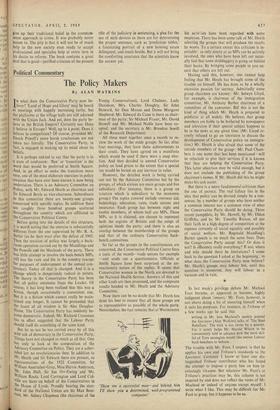CRIME No Simple Truths
R. A. CLINE writes:
Anyone concerned with the practice and organisation of the English criminal law is bound by now to have caught a whiff of the prevailing reformist zeal. The safeguards which our legal system prescribes for questioning people in cus- tody, although born of good intentions, seem to have become a godsend to the astute crook, a standing temptation to the policeman to circum- vent its handicaps and a complicated game be- yond the understanding of guileless onlookers. Its methods of sentencing baffle many who have never even heard of John Gordon's column. Criticism and self-criticism is the order of the day. A committee is sitting to consider the rules of evidence. The judges and magistrates are even now, as the Scots say, 'communing' on sentencing policy.
It is therefore without the smallest inclination to be obscurantist or resistant to new ideas or suspicious of a new breed of specialist that one listens to the views of the criminologist. If the stage scenery is to be changed, what better than to have the most expert advice available? In this spirit one opens Mr. Howard Jones's Pelican Original, Crime in a Changing Society, recognis- ing that criminology is not a fully developed science but hoping that we are going to be shown the positive contribution it can make to the pre- vention and cure of crime. I wish that it could be said that Mr. Jones illuminates that contribution. He does not. Like so many criminologists he is at his best in demolishing other people's attitudes. He can show without much difficulty, that their views are not based on facts. Unfortunately there seem to be few facts to support his own proposi- tions and one is tempted to say : 'Well, if this is science, I prefer the hunch of the man with in- sight.' There seems to be no solid ground any- where, simply statistics which are hopelessly in- adequate (through no fault of Mr. Jones).
To be fair to him, Mr. Jones does not shrink from pointing out the weaknesses of his position. Criminal statistics are very imperfect as a re- flection of the actual crime picture. You start with the number of persons found guilty of crimes; these are the ones the police have been able to
solve and prove in a court of law. They represent the minimum basis of the crime problem, the tip of the iceberg. But there are dozens of offences committed of which the police know but take no action, and there are of course the even largo' number which are never reported to them at 311, described as the 'Dark Number' of crime.
How then is it possible at present to say of a given offender that any particular treatment has in fact cured him unless he himself has been wholly and continuously frank with those respon• sible for recording the effect of the treatment or unless he is watched with a vigilance beyond the capacity of most probation officers or after-care officials? He may have become a reformed character. He may equally have learned how to keep his offences among the Dark Number. In this uncertain twilight the criminologist has to decide whether the treatment has been effective or not.
It has to be said that there are no simple ti tabs or scientific laws in this field of inquiry. To take an example: before the war it was frequ,:nflY said, with what T. S. Eliot would have describ:rd as an 'assurance of certain certainties: that poverty caused crime. Was this true? Mr. Jones frankly points out that despite all the impross:' ments in economic conditions 'crime in this country is running at a higher level than ever before' and 'the United Nations in a recent report has pointed out that juvenile delinquency has tended to increase most in those countries s4 Europe in which the standard of life is highest-- in the poorer countries of southern Europe it has increased hardly at all.. Now what is the lesson to be drawn, if anY? According to Mr. Jones it is: that a factor, such as poverty, which may be of the greatest importance at one time may at another time and under other social conditioni be of no importance at all. Many factors seal to affect our crime position. if one wanes, another may wax. Indeed the very fact of change may be the important thing sometimes.
This is the embryo of an embryo of a scientific law!
By the modern criminologist criminal be' haviour is seen as a disease, an abnormalitY requiring treatment, not punishment. Samuel Butler can claim the honours for this concept. his Erewhon sixty years ago he describes a mythical country where to catch a cold or other illness was a crime, to commit a crime was a disease. It may be that our community will finallY accept this approach, but one thing is quite certain: it will not do so until it can be reasonablY sure that the treatment is effective, and that d:IY still seems a long way off.
This book will not persuade the die-hards t° give up their traditional belief in the common- sense approach to crime. It was probably never meant to. The pity is that it will not be of much help to the new society man ready to accept Professional and specialist help at every turn in his desire to reform. The book contains a great deal that is good—justified criticism of the present role of the judiciary in sentencing, a plea for the use of such devices as there are for determining the proper sentence, such as 'prediction tables,' a fascinating portrait of a new housing estate delinquent, and much beside. But it will not bring the comforting assurance that the scientists know the answer yet.







































 Previous page
Previous page